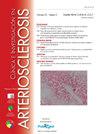sICAM-1 浓度与缺血性中风患者对侧颈动脉斑块的炎症有关。
IF 1.9
Q3 PERIPHERAL VASCULAR DISEASE
引用次数: 0
摘要
背景:超过15%的缺血性中风是颈内动脉粥样硬化斑块引起的。颈动脉 18F- 氟脱氧葡萄糖正电子发射断层扫描(18F-FDG PET)可检测斑块炎症。血浆 ICAM-1 和 LRP1 的浓度与同侧颈动脉斑块的炎症有关。本研究旨在检测这些生物标志物的可溶性(s)形式与对侧颈动脉斑块之间的关联:方法:对 53 名近期发生缺血性脑卒中且双侧颈动脉至少有一个动脉粥样硬化斑块的患者进行前瞻性研究。所有患者均接受了早期颈动脉18F-FDG PET检查,并在7±1天时采集了血液样本。采用 Multiplex 方法评估了几种血浆炎症标记物,并采用商用 ELISA 方法测量了 sLRP1 的水平。采用双变量和多变量线性回归评估炎症标志物与临床变量(包括对侧最大标准化摄取值(SUVmax)和18F-FDG摄取的平均SUVmax(对侧和同侧SUVmax的平均值))之间的关系。在评估复发情况时,采用Cox模型对潜在的混杂因素进行了调整,从而估算出危险比(HR):多变量线性回归分析显示,sICAM-1和sVCAM-1与平均SUVmax之间存在独立关联(CI=-0.064-0.325,P=0.004;CI=0.079-0.554,P=0.010)。此外,在双变量回归分析中,sICAM-1与对侧SUVmax相关(CI=0.049-0.382,P=0.012)。Cox回归显示,平均SUVmax与中风复发有关(HR=5.604,P=0.044)。结论:sICAM-1与平均颈动脉斑块炎症和对侧斑块炎症独立相关。本文章由计算机程序翻译,如有差异,请以英文原文为准。
sICAM-1 concentrations are associated with inflammation in contralateral carotid plaque in patients with ischemic stroke
Background
Atherosclerotic plaques in the internal carotid artery are responsible for more than 15% of ischemic strokes. Carotid 18F-fluorodeoxyglucose positron emission tomography (18F-FDG PET) detects plaque inflammation. Plasma ICAM-1 and LRP1 concentrations have been associated with inflammation in ipsilateral carotid plaque. The aim of the present study was to test the association between the soluble (s) form of these biomarkers and contralateral carotid plaques.
Methods
Prospective study conducted in 53 patients with a recent ischemic stroke and at least one atherosclerotic plaque in both carotid arteries. All of the patients underwent an early carotid 18F-FDG PET, and a blood sample was obtained at 7 ± 1 days. Several plasma inflammatory markers were evaluated by Multiplex and sLRP1 levels were measured by commercial ELISA. Bivariate and multivariable linear regression was used to assess the association between inflammatory markers and the clinical variables, including contralateral maximum standardized uptake value (SUVmax) and mean SUVmax (mean of contralateral and ipsilateral SUVmax) of 18F-FDG uptake. Hazard ratio (HR) was estimated with Cox models adjusted for potential confounding factors to evaluate recurrence.
Results
Multivariable linear regression analysis showed an independent association between sICAM-1 and sVCAM-1 and mean SUVmax (CI = −0.064–0.325, p = 0.004; CI = 0.079–0.554, p = 0.010). In addition, in bivariate regression analysis, sICAM-1 was associated with contralateral SUVmax (CI = 0.049–0.382, p = 0.012). Cox regression showed that mean SUVmax was associated with stroke recurrence (HR = 5.604, p = 0.044).
Conclusions
sICAM-1 was independently associated with mean carotid plaque inflammation and with inflammation in contralateral plaque. sICAM-1 could be an indicator of plaque inflammation even in asymptomatic plaques.
求助全文
通过发布文献求助,成功后即可免费获取论文全文。
去求助
来源期刊

Clinica e Investigacion en Arteriosclerosis
PERIPHERAL VASCULAR DISEASE-
CiteScore
3.20
自引率
6.20%
发文量
44
审稿时长
40 days
期刊介绍:
La publicación idónea para acceder tanto a los últimos originales de investigación como a formación médica continuada sobre la arteriosclerosis y su etiología, epidemiología, fisiopatología, diagnóstico y tratamiento. Además, es la publicación oficial de la Sociedad Española de Arteriosclerosis.
 求助内容:
求助内容: 应助结果提醒方式:
应助结果提醒方式:


